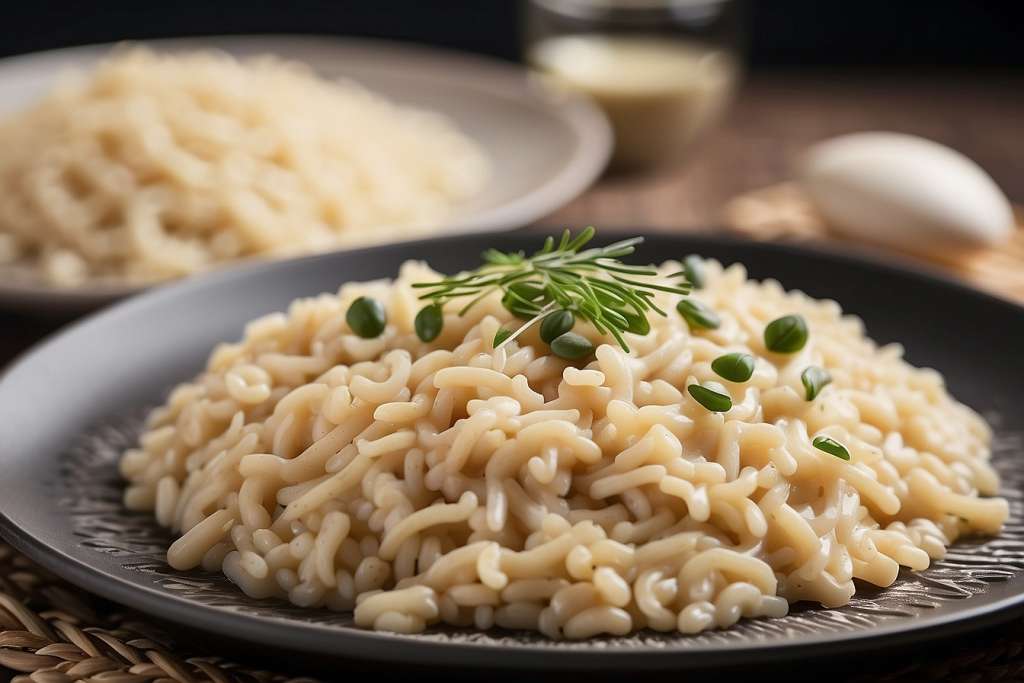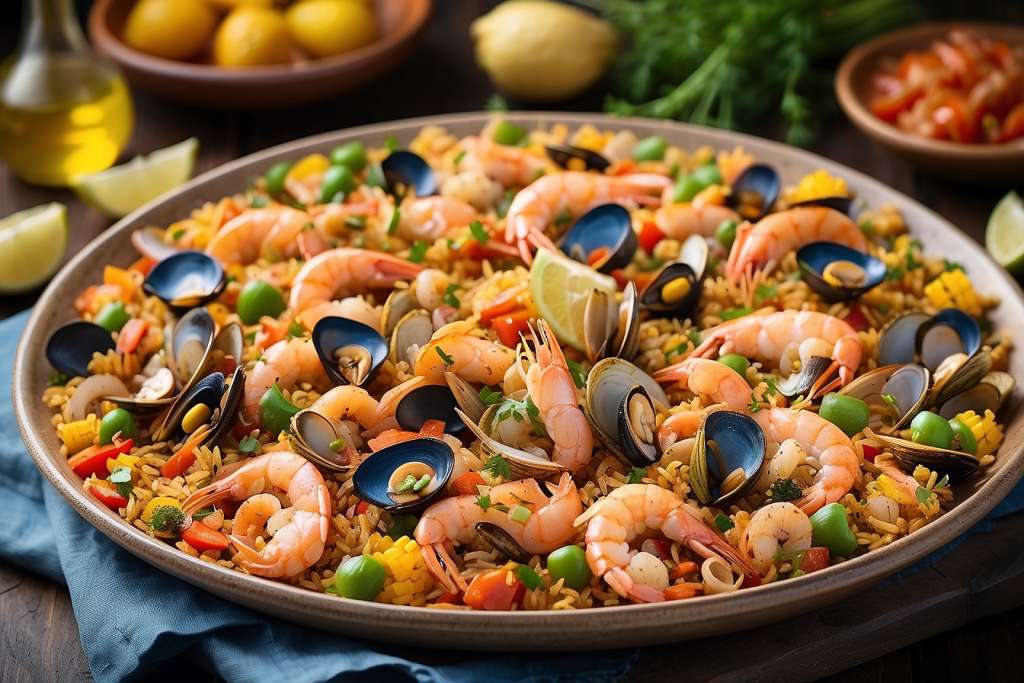No, risotto rice and paella rice are not the same. The main distinction between them lies in their starch content and cooking methods, resulting in different textures and flavors in the dishes.
Risotto primarily uses Arborio or Carnaroli rice, both of which are short-grain varieties with a high starch content. This starch is released during the slow stirring process, creating the creamy consistency that defines authentic risotto.
In contrast, paella traditionally employs Bomba rice or Calasparra rice. These varieties have a sturdier texture that absorbs liquid well without becoming overly soft, allowing the rice to maintain its shape and form a desirable socarrat, or crispy bottom layer.
In summary, while both types of rice are short-grain, their unique characteristics and intended cooking techniques lead to distinct results in risotto and paella dishes.
Risotto 101: Toasting Tradition with Arborio
When that craving strikes for velvety, opulent rice awash in savory Parmesan and butter, only proper risotto will satisfy. Originating in Italy’s late 19th century, risotto remains beloved thanks to its creaminess contrasting al dente rice kernels. But what exactly constitutes authentic risotto?
Rules of Risotto Construction
- Italian Arborio Rice: This short-grain, starchy variety gives risotto its signature creaminess since more starch is released during cooking compared to long-grain rice. This enables the broth to absorb into the rice instead of clumping or becoming mushy.
- Gradual Addition of Hot Liquid: Unlike most rice dishes, risotto is prepared by slowly pouring hot broth in increments while continuously stirring to allow for maximum absorption into the grains. This liberates starch to amplify decadence.
- Constant Stirring Over Low Heat: Vigilant stirring enables even starch distribution for smooth texture rather than clumping or mushiness on the bottom of the pan. Low, gradual heat allows liquid to fully absorb without making the rice tough or crunchy.

Arborio rice is specially formulated not only to deliver rich, round body, but also to retain that crucial al dente bite even when drenched in sauce – a prime point of differentiation from paella rice.
Risotto Rice Reigns For…
- Decadent, creamy consistency
- Contrast of soft and al dente
- Abundant starchiness and fat
- Gradual build of complex flavors
- Ability to absorb other ingredients
Now that we’ve reviewed how orthodox risotto relies wholly on plump Italian Arborio, let’s explore the special Spanish rice varieties that fuel fabulous paella.
Paella 101: Treasured Rice of Valencia
While risotto seduces with its voluptuous body, paella captivates with contrasting flavors and textures in one vibrant dish. Originally an agricultural worker staple combining local rice, vegetables, beans and snails, paella today stars seafood, poultry, sausage and more over bomba or calasparra rice. But how does paella rice differ in taste and performance? Let’s find out!
The Origins of Paella Rice
Unlike risotto’s exclusive use of Arborio, traditional paella employs two Spanish short-grain specialty rice varieties sharing the characteristics below:
Bomba Rice
- Grown near Valencia in Spain’s fertile coastal delta
- Kernels triple in size when cooked
- Abundant starch enables maximum absorption
- Sturdy structure maintains integrity amidst diverse ingredients
Calasparra Rice
- Cultivated just west in the arid mountains of Murcia
- Lower yield and smaller grains
- Imparts enticing nutty flavor
- Retains more bite than bomba
Both bond beautifully with saffron-infused broth and offer that crucial socarrat – the prized crispy crust blanketing the bottom layer of rice rewarding paella devotees with caramelized crunch in each bite.
Paella Rice Reigns For…
- Nutty, robust flavor dimension
- Preserving texture amidst ingredients
- Signature socarrat crust
- Starch absorbing herbs, seasonings
- Rice as co-star not just base
Table 1: Key Characteristics of Risotto vs. Paella Rice Varieties
| Rice Type | Rice Varieties | Kernel Description | Cooking Method | Texture | Flavor |
|---|---|---|---|---|---|
| Risotto | Arborio | Short grain; high starch content | Gradually added hot liquid with constant stirring | Creamy, smooth | Neutral |
| Paella | BombaCalasparra | Short grain; high starch contentSmaller grains, lower yield | Dry heat absorptionSocarrat crust formation | Firm exterior to retain shapeSome bite retained | NuttyRobust |
Now for the final face-off between these distinguished Spanish and Italian grain varieties! Which factor matters most?
The Supreme Starch: And the Winner is…
While risotto and paella remain classics in their own right, a deeper look at crafting techniques, rice characteristics and dish outcomes reveals a clear victor for versatility…

The Superior Specimen is…Paella Rice!
Since Spanish bomba and calasparra rice varieties can succeed in both wet and dry cooking methods, they claim more flexible functionality. Their sturdy exteriors that resist dissolving in sauce plus subtly nutty flavor also make them more versatile for pairing with diverse ingredients from seafood to wild mushrooms to beans and veggies.
Table 2: Advantages of Paella Rice Over Risotto Rice
| Paella Rice Advantage | Details |
|---|---|
| Versatile cooking methods | Can succeed in wet or dry applications |
| Texture retention | Sturdy grains maintain integrity in diverse ingredients |
| Enhanced flavor profile | Subtly nutty notes shine |
| Socarrat crust potential | Crispy, caramelized bottom layer |
| Broad ingredient pairability | Complements proteins, veggies, beans, etc. |
While Italian Arborio is specially formulated for creaminess critical in authentic risotto, it can become mushy or clump when not stirred constantly in gradual liquid for even absorption. Beyond classic risotto applications, Arborio lacks the fortitude and neutral flavor of Spanish rice to shine.
So when it comes to an adaptable grain able to transform broth to burnt crisp and anything between, hardy Spanish bomba and calasparra rice varieties are the undisputed paella paladins!
Risotto may delight devoted dairy and starch enthusiasts with indulgent opulence, but cannot compete with paella rice’s versatility, complexity and depth of flavor sure to convert even the most die-hard risotto loyalist. ¡Olé!
If the idea of sizzling seafood or smoky chorizo atop golden paella has your mouth watering, head to Mediterranean Grill or La Paz to sample authentic Valencian renditions right here in town! Or try crafting the iconic Spanish dish yourself using our handy how-to guide for beginner cooks next!


